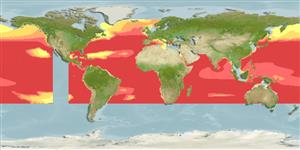Teleostei (teleosts) >
Stomiiformes (Lightfishes and dragonfishes) >
Sternoptychidae (Marine hatchetfishes) > Maurolicinae
Etymology: Valenciennellus: From Achille Valenciennes 1794-1865; he worked with Duméril, Cuvier and Lacepède since 1815; malacologist, author of a "Histoire naturelle des poissons" (Ref. 45335).
Eponymy: Achille Valenciennes (1794–1865) was a French zoologist; primarily an ichthyologist and conchologist. [...] (Ref. 128868), visit book page.
Environment: milieu / climate zone / depth range / distribution range
Ecology
Marine; bathypelagic; non-migratory; depth range 100 - 1000 m (Ref. 74511), usually 200 - 400 m (Ref. 4462). Deep-water; 67°N - 34°S, 98°W - 117°W
Worldwide in tropical to temperate waters (Ref. 37039). Eastern Atlantic: scattered records in Iceland, Ireland, Mediterranean Sea, also from Portugal southward to Namibia. Western Atlantic: Gulf of Mexico (Ref. 27768). Northwest Atlantic: Canada (Ref. 5951). Eastern Pacific: California Current region (Ref. 35838). South China Sea (Ref.74511).
Length at first maturity / Size / Weight / Age
Maturity: Lm ?, range 3 - ? cm
Max length : 3.1 cm SL male/unsexed; (Ref. 4462); 3.1 cm SL (female)
Dorsal spines (total): 0; Dorsal soft rays (total): 7 - 10; Anal spines: 0; Anal soft rays: 22 - 25. Silvery in color during the day, darker at night. Branchiostegal rays: 9-10 (Ref. 35838). Unique arrangements of the photophores on the tail, five separated groups containing 2-4 light organs (Ref. 37473).
Oceanic and mesopelagic, with marked stratification of size with depth (Ref. 4739). Generally non-migrant or only short diel vertical migrations (Ref. 4739). A selective daytime feeder on copepods (mainly Pleuromamma and ostracods, Conchoecia) (Ref. 4739). Also Ref. 58302.
Annual species probably spawning year round (Ref. 4739). Spawns more than once with egg batches about 100-360 eggs/ovary pair, the number increasing with animal size (Ref. 4739).
Quéro, J.-C., J.C. Njock and M.M. de la Hoz, 1990. Sternoptychidae. p. 275-282. In J.C. Quero, J.C. Hureau, C. Karrer, A. Post and L. Saldanha (eds.) Check-list of the fishes of the eastern tropical Atlantic (CLOFETA). JNICT, Lisbon; SEI, Paris; and UNESCO, Paris. Vol. 1. (Ref. 4462)
IUCN Red List Status (Ref. 130435: Version 2024-1)
Threat to humans
Harmless
Human uses
Tools
Special reports
Download XML
Internet sources
Estimates based on models
Preferred temperature (Ref.
123201): 8.1 - 19, mean 12.7 °C (based on 680 cells).
Phylogenetic diversity index (Ref.
82804): PD
50 = 0.7500 [Uniqueness, from 0.5 = low to 2.0 = high].
Bayesian length-weight: a=0.01122 (0.00514 - 0.02450), b=3.04 (2.87 - 3.21), in cm total length, based on all LWR estimates for this body shape (Ref.
93245).
Trophic level (Ref.
69278): 3.1 ±0.24 se; based on food items.
Resilience (Ref.
120179): Medium, minimum population doubling time 1.4 - 4.4 years (tmax=1; tm<1; Fec=100-360 (annual<1000)).
Fishing Vulnerability (Ref.
59153): Low vulnerability (10 of 100).
